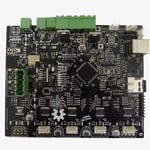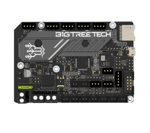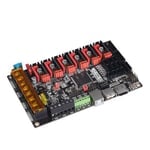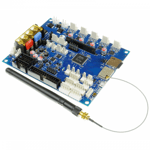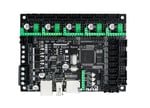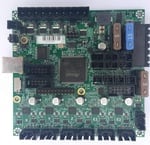The controller board is responsible for all the electronic functioning of a 3D printer. Without it, the printer wouldn’t be able to do much more than turn certain components on and off at the manual flick of a switch.
Controller boards handle all the logic behind 3D printing, such as parsing G-code files, regulating temperature, and most importantly, controlling motion. The latter is particularly important if we’re talking about FDM and stepper motors.
Whether you’re considering an upgrade or simply replacing a broken part, choosing the right controller board for your printer isn’t the most straightforward task. Since there are so many brands and models on the market today, we’re here to help! Read on to check out some of the best 3D printer controller boards available.
Considerations
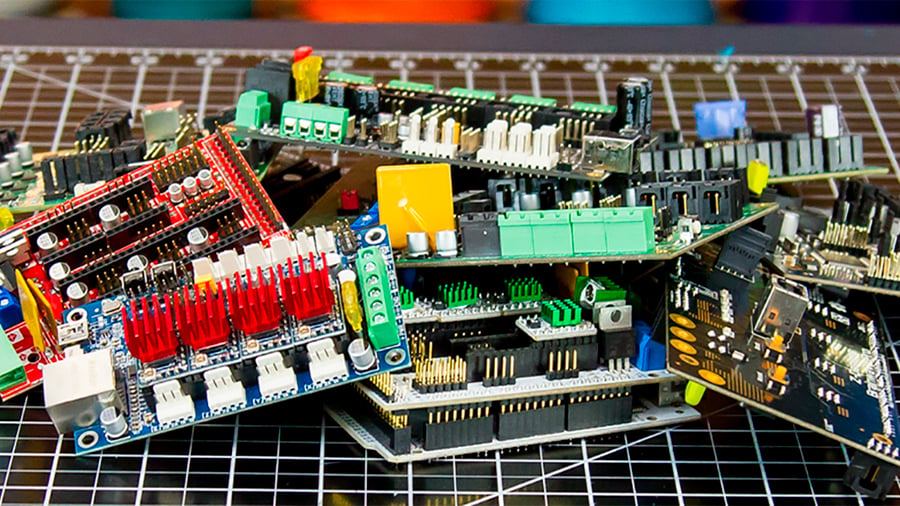
What started as a landscape of bare-bones boards trying hard to simply get the job done has turned into a packed marketplace of technological beauty. Controller boards have not only become more powerful but also more diverse, offering new features that have been moving the 3D printing industry forward.
Our selections in this article are primarily based on three considerations:
- Advanced features support: Open-source 3D printing firmware is in constant and rapid improvement, with new features periodically released to enhance our machines’ capabilities. Hardware is slowly catching up, and whether you’re planning to replace or upgrade your board, it’s probably a good idea to get controller boards compatible with advanced features like 1/256 microstepping, UART Mode, and Wi-Fi, among others.
- Processor performance: 32-bit boards are increasingly popular. Having powerful processors will ensure that your 3D printer will be able to handle the aforementioned advancements in firmware for at least the next two years .
- Popularity: For the uninitiated, changing a 3D printer’s controller board might sound like brain transplanting. Well, it’s nowhere near that hard, but configuring new firmware and figuring out all the connections and modes can feel a bit overwhelming. That’s when a good user community comes in, with troubleshooting tips and even preconfigured firmware. Moreover, popular controller boards are popular for a reason, and that reason is usually reliability.
In the following sections, we present controller boards that are worth checking out. We’ve included the most important details about each board, but given the current microchip shortage and supply chain issues experienced around the world, the availability of boards and their prices are in flux. Although we’ve done our best to report prices current at the time of publication, you may find that there’s quite a bit of price variation among retailers.
Lerdge-Z

Replacing a 3D printer controller board can be a daunting process. Pairing your specific hardware to open-source firmware like Marlin requires setting up the firmware and code compilation. Although the process isn’t that hard, it can be complicated for some users.
The Lerdge-Z controller board aims to simplify the setup process as much as possible. All the firmware setup is done directly at the touchscreen display of the printer, so no coding or compiling is required. This board is compatible with different 3D printing setups, including CoreXY and delta printers.
Replacing the older -X and -K models, the Lerdge-Z runs with a 32-bit processor and offers compatibility with TMC drivers (although lacking UART and SPI support). This controller board, however, requires its own matching 3.5-inch touchscreen display to work properly.
- Microcontroller: STM32F407VET
- Connections: USB, MicroSD card
- Input power: 10 to 28 V
- Built-in drivers: No
- Price: ~$85 (with the 3.5-inch touchscreen display included)
Smoothieboard v1
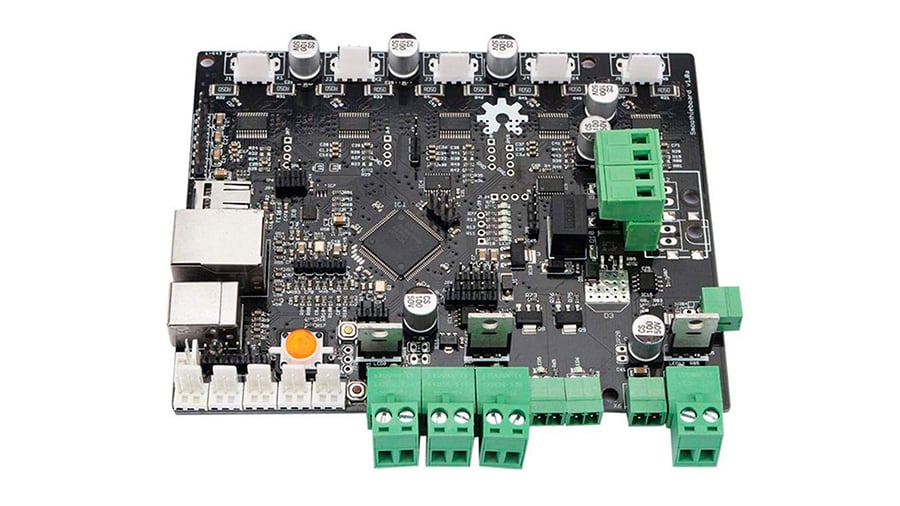
The Smoothieboard is a veteran showstopper. To start off, it’s a 32-bit board boasting a 120-MHz processor, way ahead of the older ATMega chips that only clock 8 MHz.
The v1 comes with built-in stepper drivers (A5984) and there are a few versions to choose from, varying according to the number of drivers: the Smoothieboard 3X has three drivers, the 4X has four, and the 5X – you guessed it – has five. (The number of drivers is the only significant difference between versions.)
Another major thing this board did right is firmware. When the Smoothieboard was initially developed, Marlin and Repetier couldn’t run on 32-bit boards. So, on top of making hardware, the company also wrote brand new firmware to match. Thus, the open-source Smoothieware was born. Since then, many 32-bit derivates of the Smoothieboard conveniently make use of Smoothieware, which is as capable as Marlin or Repetier, but easier to configure.
- Microcontroller: LPC1769
- Connections: USB, Ethernet, MicroSD card
- Input power: 12 to 24 V
- Built-in drivers: Yes (A5984)
- Price: $150+ for the 5X version
SKR Mini E3 V3
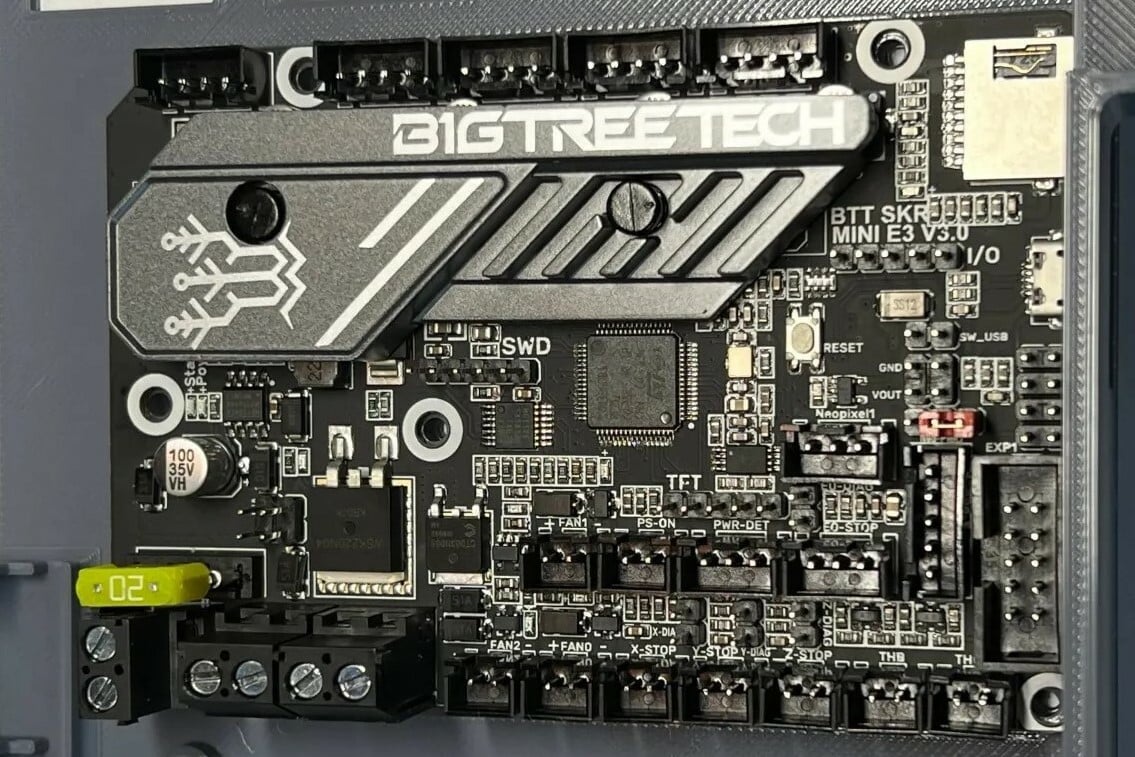
Developed by the good folks at BigTreeTech in Shenzen, China, the SKR Mini E3 board was specifically designed as a drop-in replacement and upgrade board for Creality 3D printers like the Ender 3. And it’s quite a replacement, with a 32-bit microcontroller and super-quiet onboard TMC2209 drivers capable of sensorless homing.
The latest revision, the V3, improves greatly on the thermal side. With an improved solid heat spreader block, the drivers can supply a higher current for an extended period of time without overheating. This is great for those looking to reach faster speeds or tighter accelerations. A faster MCU grants a higher stepping frequency cap and solves any memory limitation linked to firmware flashing.
To top it all off, the revised I/O integrates one more fan port, support for both 3.3- and 5-V SPI logic, and a plethora of dedicated connectors for LEDs, leveling sensors, and power modules.
- Microcontroller: STM32G0B1RET6 or STM32G0B0RET6
- Connections: Micro-USB, MicroSD card
- Input power: 12 to 24 V
- Built-in drivers: Yes (TMC2209)
- Price: ~$37
SKR 3

While the Mini E3 is tailored towards Creality printers, the SKR 3.0 has the completely opposite goal: versatility. It can be easily adapted to most existing printers without too much work. The successor of the SKR 2.0, this latest iteration mounts a Cortex-M7 clocked at a frequency of 480 MHz, as well as an improved output current of 5 A. This last feature in particular allows the user to power all sorts of modules and extensions, including a Raspberry Pi.
Alongside the new and improved MOSFET cooling and the thermistor protections, the SKR 3.0 offers three addressable fan connections with adjustable voltage. Furthermore, it’s predisposed to wire in PT100 thermistors, without external modules. Wi-Fi is supported as well but requires an expansion module that can be purchased separately.
This board offers full UART control for five Trinamic drivers (not included) and dual extrusion right off the bat. The EZ variant offers the same specs but integrates an innovative driver mounting system that allows you to rapidly swap them.
- Microcontroller: STM32H743VIT6
- Connections: 2 x USB, MicroSD card
- Input power: 12 to 24 V
- Built-in drivers: No
- Price: ~$65
SKR Pro 1.2

The SKR Pro is BigThreeTech’s ultimate solution for high-level 3D printing. It boasts the same ARM 32-bit Cortex-M4 chip as the SKR 2.0, which clocks at 168 MHz. However, it offers more hardware capabilities than any other BigTreeTech board.
Starting with the numbers, this board can handle six motors, three extruders, three controllable fans, two displays, and supports dual Z-axis ports. It also offers 20 expansion ports for PWM, ADC, UART, and other protocols for peripherals, plus the conventional Wi-Fi expansion port.
Additionally, the 12- to 24-V power is supplied in separate lines: one for the motors, one for the heated bed, and another for the board itself. All in all, the SKR Pro 1.2 has tremendous hardware capabilities, but as reported by some users, the documentation required for setting up and running such a complex board lacks depth.
- Microcontroller: STM32F407VGT
- Connections: 2 x USB, MicroSD card
- Input power: 12 to 24 V
- Built-in drivers: No
- Price: ~$60
SKR Manta M4P
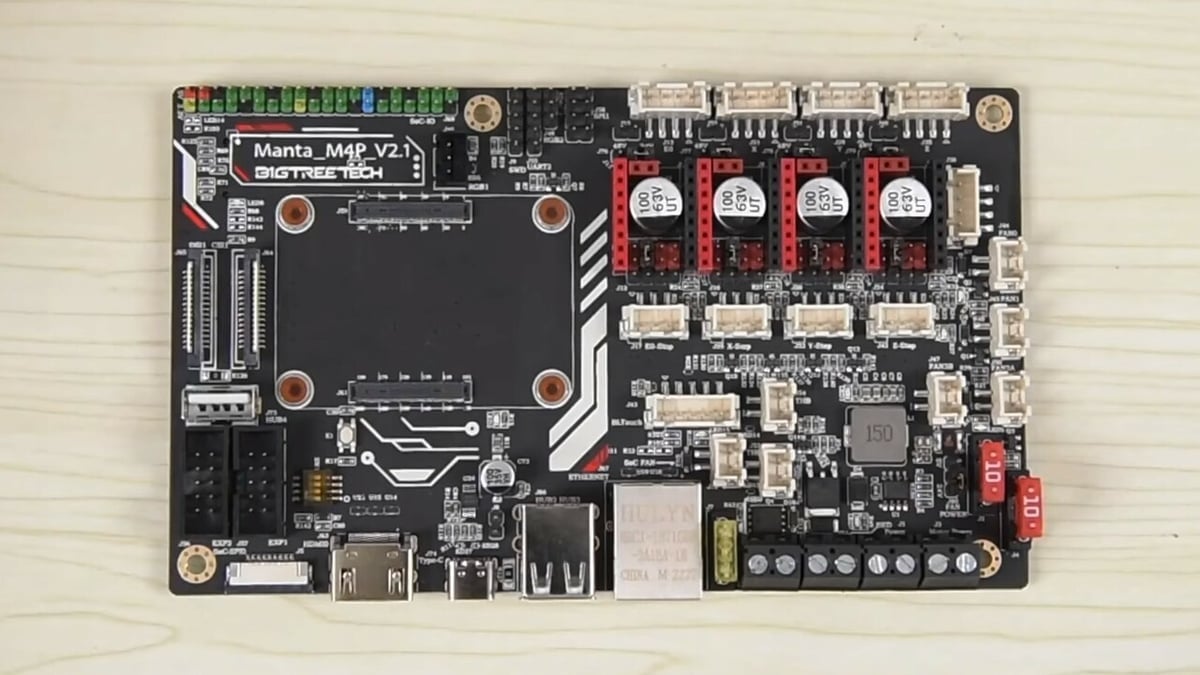
When Klipper announced BTT as their first main sponsor, we knew it was only a matter of time before a bespoke card was released. The Manta M4P is just that, with effectively two controllers in one place. A 32-bit STM32G0B0RE MCU handles all the I/O and onboard connectors, including drivers, fans, display, and so on. Then, thanks to the predisposed connectors and ports, a Raspberry Pi Compute Module 4 can be plugged in on top of the board. Klipper can then be installed on the CM4 and will connect to the MCU directly – no need for USB cables.
This solution is great as it removes the need for separate power and data delivery to the Pi, which might get messy in an enclosure. The board designers have planned everything: You’ll still have the option to plug in a CSI camera or a DSI screen, a screen via SPI, and many other modules via the integrated GPIO and USB ports. Its bigger brother, the Manta M8P, supports four additional drivers and several other connectors.
Is the Compute Module hard to find? No worries, as BTT released their own version, the CB1, which can perform the same tasks. The board can be flashed with Marlin, of course, and can work independently of any SBC.
- Microcontroller: STM32G0B0RE
- Connections: 2 x USB, MicroSD card, Ethernet, 2 x CSI
- Input power: 12 to 24 V
- Built-in drivers: No
- Price: ~$40
Duet 3 Mini 5+

The latest revision from Duet3D, the Duet 3 Mini 5+ represents a decent upgrade over its predecessor. While not the most powerful (or expensive) model of the lineup, it’s the spiritual successor to their previous best-seller, the Duet 2 WiFi. With the new and improved TMC2209 drivers, CAN-FD bus support, and three high-current PWM outputs, the Duet 3 Mini 5+ has something to boast about. Overall, the design team decided to go with a more conservative approach to drive the price down and avoid some potentially unused features.
The board itself isn’t a drop-in replacement for the previous model. The newer TMC2209 stepper drivers support StallGuard 2 and StealthChop2, but the previous TMC2660 had a peak current of 2.4 A. The Duet 3 Mini 5+ gains two more I/O connectors for a total of seven, as well as four controllable fans. This time around the controller can be configured to connect either via Wi-Fi or Ethernet and integrates a dedicated high-speed bus for an external SBC.
Yet, this board is perhaps best known for its unique RepRapFirmware. This firmware supports an impressive array of movement systems, including the Hangprinter and multiple independent axes from the likes of the BCN3D Sigma. Depending on the mechanics of the machine you want to power, this could be the only controller board that’ll fulfill your demands. And the price reflects that.
- Microcontroller: STM32G0B0RE
- Connections: 2 x USB, MicroSD card
- Input power: 11 to 25 V
- Built-in drivers: Yes (TMC2209)
- Price: ~$150
Re-ARM
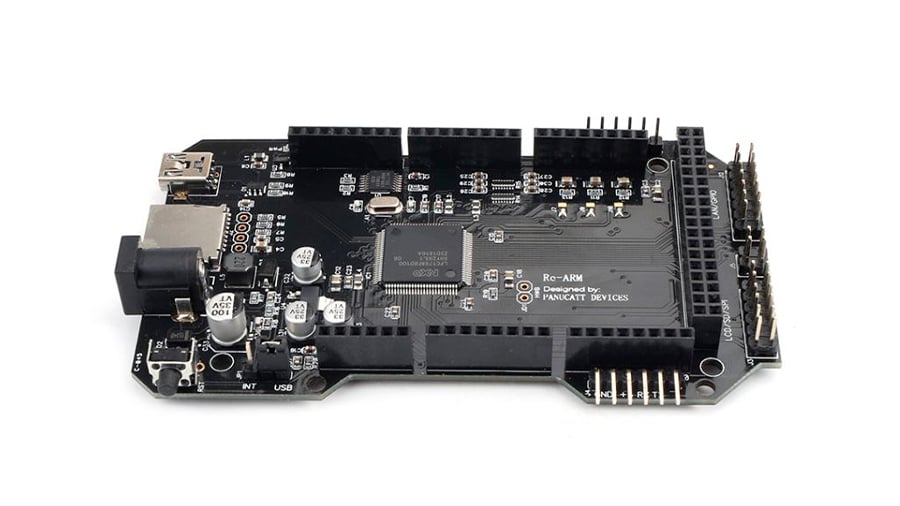
The boards presented here all seem great, but upgrading a controller board might not go as smoothly as it might sound. Think of all the documentation reading, software configuration, and even connector’s compatibility. The Re-ARM bypasses most of these steps as it was designed to be a plug-in replacement of the Arduino Mega on a RAMPS combo.
Featuring a 32-bit LPC1768 chip, it’s possibly the fastest option for upgrading your 8-bit Arduino Mega, as it’s fully compatible with RAMPS 1.4 and 1.6. The Re-ARM runs open-source firmware so you can choose Marlin 2.0 or Smoothieware as well.
- Microcontroller: LPC1768
- Connections: Micro-USB, MicroSD card
- Input power: 10 to 30 V
- Built-in drivers: No
- Price: ~$45
MKS Robin Nano V3.1

While we’ve covered both mid- and high-range boards, we still haven’t mentioned a budget option for those looking for it. Sometimes, you don’t need the top-of-the-line, but rather a cheaper 32-bit controller to upgrade from your older 8-bit mainboard. For those looking to do so, the Makerbase Robin Nano V3.1 is here to help.
Mounting a 32-bit STM32F407VET6 clocked at 168 MHz, it integrates support for two hot end heaters, two fans, a Wi-Fi module, and five steppers, alongside the usual I/O for probes and peripherals. In terms of safety, the latest V3.1 revision integrates protective Schottky diodes for each thermistor and a TVS diode for the power input. That said, there are no replaceable fuses on the power circuitry, only surface-mounted ones.
The board is fully compatible with UART and STEP/DIR drivers such as the TMC2209 or the TMC2225 and supports a variety of TFT screens.
- Microcontroller: STM32F407VET6
- Connections: Micro-USB, MicroSD card, Ethernet (optional)
- Input power: 12 to 24 V
- Built-in drivers: No
- Price: ~$38
Octopus Pro V1.0

If you’re looking to expand your printer’s capabilities in terms of stepper motors, fans, and other control-dependent components, then the Octopus Pro is meant for you. With support for up to eight drivers, eight fans, six endstops, four hot end heaters, five temperature sensors, and much more free GPIO, you’ll hardly run out of ports. The entire assembly is powered by a 32-bit, 180-Mhz MCU, with up to 1 MB of flash memory to fully support the RepRap firmware.
The board itself is designed around versatility: It supports PT100/PT1000 probes, a Wi-Fi module, TFT screens, and a stepper voltage of up to 60 V. In terms of safety, the Octopus offers a 5-V short circuit alarm and individual driver isolation chips to protect the mainboard from any fault. Additionally, separate power lines for the board, motors, and bed are predisposed by default, allowing the user to power each of them from a different PSU.
In terms of connections, the Octopus features USB-C and USB-A, as well as a MicroSD card slot, and a CAN bus-enabled Ethernet port. BTT has the Marlin, Klipper, and RepRap firmware source files available on their GitHub page.
- Microcontroller: STM32F446ZET6, STM32F429ZGT6
- Connections: 2 x USB, MicroSD card, Ethernet
- Input power: 15 to 28 V
- Built-in drivers: No
- Price: ~$53
Archim2
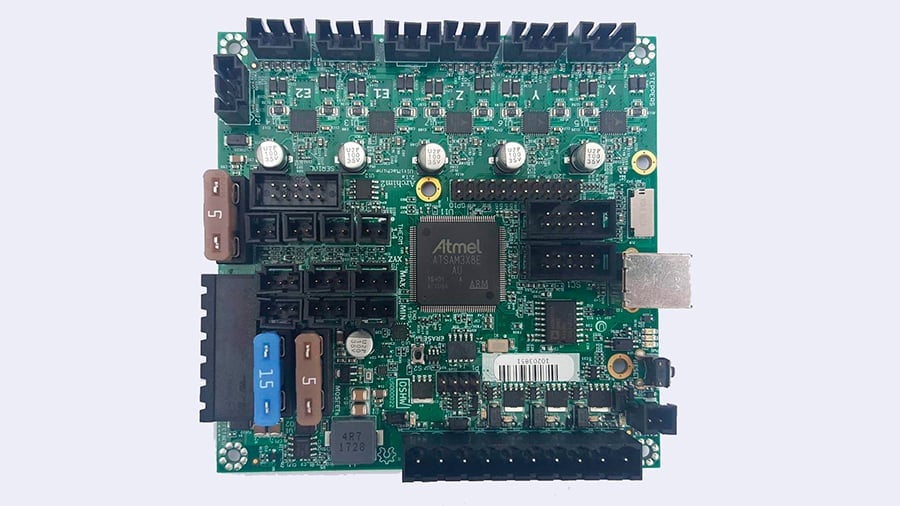
The Archim2 is named after the Greek engineer, mathematician, and inventor known as Archimedes. Like him, this board is highly multitasking, with an Atmel SAM3X8E 32-bit processor and built-in Trinamic TMC2130 drivers.
It supports up to five motors, which means dual extrusion is possible, and all five motors are capable of 1/256th microstepping. Archim runs on Marlin 2.0, and while it has a preconfigured branch called Marlin4due, it’s said support for other firmware like RepRapFirmware and Repetier may come in the future.
- Microcontroller: SAM3X8E
- Connections: USB, MicroSD card
- Input power: 10 to 24 V
- Built-in drivers: Yes (TMC2130)
- Price: ~$170
License: The text of "The Best 3D Printer Controller Boards" by All3DP is licensed under a Creative Commons Attribution 4.0 International License.
CERTAIN CONTENT THAT APPEARS ON THIS SITE COMES FROM AMAZON. THIS CONTENT IS PROVIDED ‘AS IS’ AND IS SUBJECT TO CHANGE OR REMOVAL AT ANY TIME.


